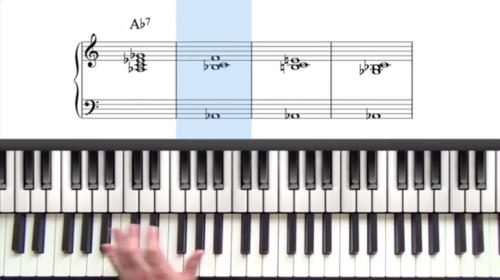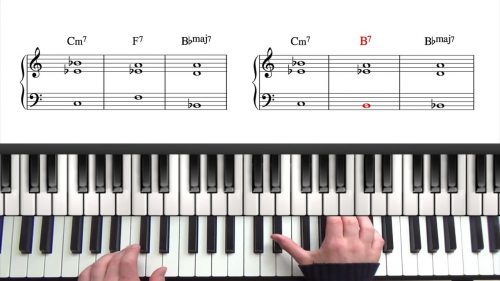Moon River Jazz Piano Tutorial
In this lesson we create a full solo piano arrangement of the tune “Moon River” incorporating interesting voicings, fills, and reharmonisations.
Moon River is a delightful jazz waltz ballad composed by henry Mancini. The tune has a very carefully constructed melody and delightful harmonic passages and cadences.
Moon River Solo Piano Arrangement
We will arrange the tune for solo piano performance using 2 handed spread voicings, passing chords, upper structure triads and altered harmony, and some interesting tritone substitutions. If any of these theory areas are new to you check out the related lessons below.
Practice Tips
-
Experiment with the melody in different registers of the piano.
-
Harmonise the melody with 3rd and 6th intervals to create more interest and texture in the upper registers.
-
Study the fills which are used when the harmony, melody, or both, are static. Fills and ornamentation enhance our solo jazz piano performance.
-
Practice both the regular changes and the reharmonisations such as tritone substitutes.







I really liked the extra rhythm you added to your left hand in the C section. Any suggestions of other places on PianoGroove for finding similar rhythm-related fills?
Hi Wendy, Apologies for the late reply here – I missed this comment.
Yes this kind of rhythmic related fill in the left hand is useful for navigating the minor line cliché such as in the tune “In A Sentimental Mood”, check out chapter 4 of this lice seminar:
pianogroove.com/live-seminars/sentimental-mood-jazz-standard/
The reason this works well is that we only have one note changing which creates a moving voice and allows us to add rhythmic interest when the voice moves.
I hope that helps to give you another example of where this could be used. The key is to watch out for that minor line cliché or some kind of slash chord notation in the bass which is usually to indicate that a moving half or whole step bass line can be used.
Cheers,
Hayden
In the B section on the E7 I used a C major triad for the 1st two melody notes follow by a Bflat triad for the D.
Hey Tim,
That’s great that you have figured out those voicings for that section. It sounds beautiful.
An important point to understand is the relationship between the 13#11 UST and the #5#9 UST.
When we play a C Triad over Bb7, we have Bb13(#11), and when we play that same C Triad over E7 (The Tritone of Bb7) we then have E7(#5#9) and so by just changing the bass note we change the flavour of the chord completely.
Interestingly here, the Bb triad gives you a b9#11 sound over the E7, and so in combination with the C Triad you play all alterations over the E7 (b9, #9, #11, and #5/b13) by using those 2 triads.
When playing USTs always ask yourself, “what would the tritone give me here” and it will immediately unlock more options for harmonising the melody.
Have fun playing around with this stuff!
Cheers,
Hayden
What a lovely rendition of this song!
Where is the beginner version. Search only reveals intermediate and advanced….
Hi Mivi,
The previous lesson in this course is a “harmonic analysis” of this tune which covers the basic chord changes, you can find that lesson here:
pianogroove.com/jazz-piano-lessons/moon-river-harmonic-analysis/
In this lesson we discuss the numerics of the original harmony without the reharmonisations and chord substitutions. This is the beginner-level tutorial that we have on this tune and it will also help you to understand the harmonic construction of the song which is useful before we add the reharmonisations.
I also hosted a seminar on this tune which you can find here:
pianogroove.com/live-seminars/moon-river-jazz-standard-workshop/
The light-up keyboard for the seminar was accidentally recorded in lower quality so the visual quality is not as sharp as usual, but hopefully it’s not too much of an issue.
Let me know if I can help further and enjoy the lessons!
Talk soon,
Hayden
Where do I find the beginner tutorial on Moon River you mention in the intro? Thank you….
HI Mivi,
Did you see my previous reply to your question?
You should be able to see it if you scroll up.
The previous lesson in this course is a “harmonic analysis” of this tune which covers the basic chord changes and voicings, you can find that lesson here:
pianogroove.com/jazz-piano-lessons/moon-river-harmonic-analysis/
This lesson will help you to understand the harmonic framework of the tune which is useful before diving too deep into reharmonisations.
There is also a seminar on this tune which you can find here:
pianogroove.com/live-seminars/moon-river-jazz-standard-workshop/
Let me know if I can help further.
Cheers,
Hayden